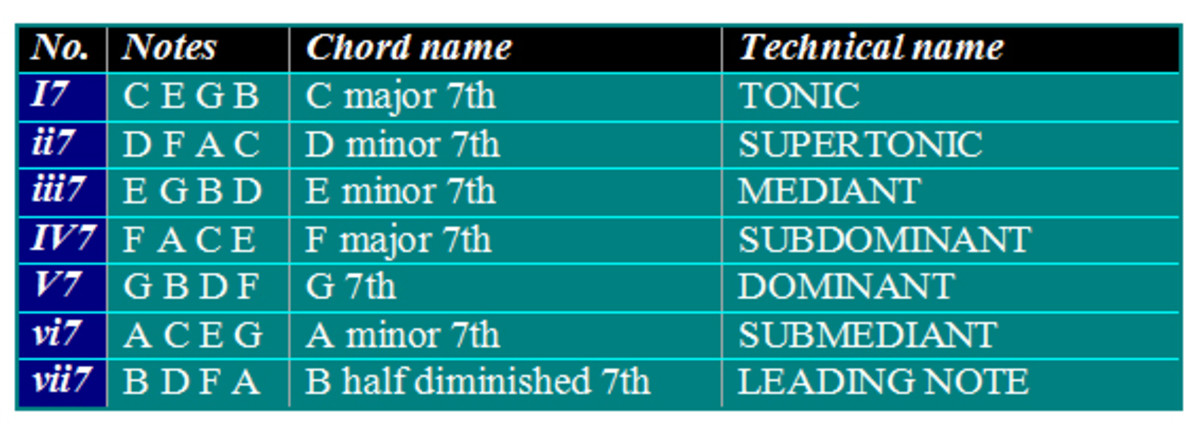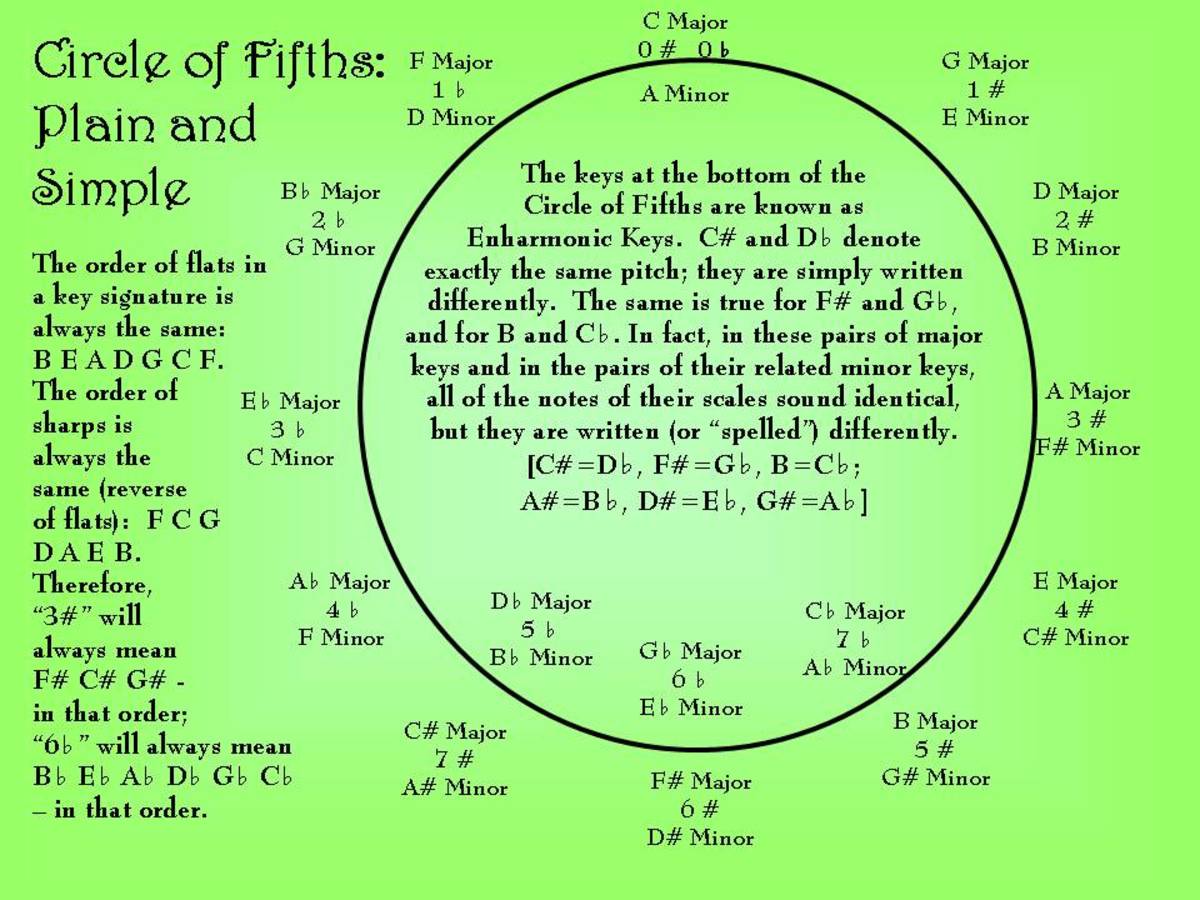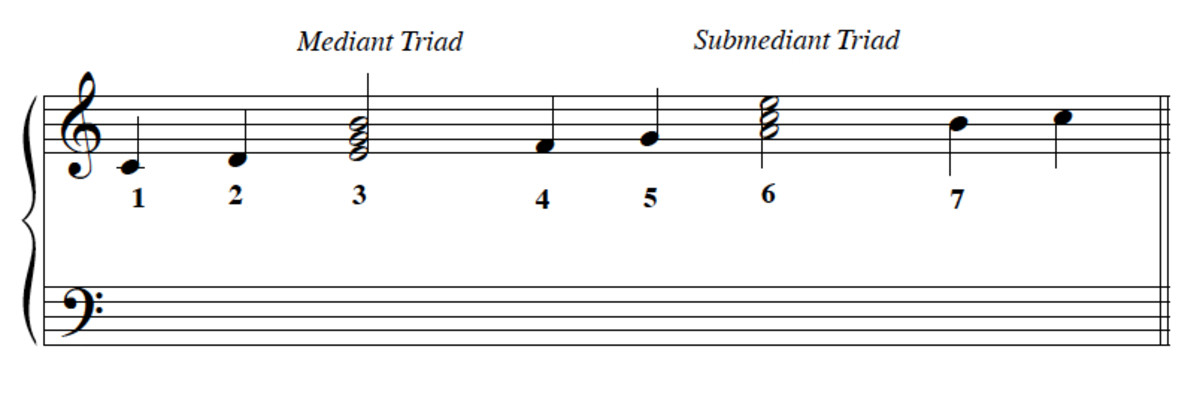Chords in a Key
Defining The Chords In A Key
The chords in a key are based off the notes of the major scale.

Some Basic Scale Theory
Go ahead and skip this section if you just want to know the chords in the various keys.
All About Intervals & How Scales Are Created
OK, you stuck around, that's fantastic! knowing this stuff really becomes helpful as you progress musically.
The intervals (the distance between each note) of a half-step and a whole-step are the foundation of scales.
Lets talk about the chromatic scale aka the half-step scale. The chromatic scale means you are playing every black and white key in order on a piano. If you start on C you'll play. C C#, D, D#, E, F, F#. G, G#, A, A#, B, C, C#. So, the chromatic scale is playing all the half steps. There will be 12 half-steps before the pattern repeats regardless of the key you choose to start on. (C# stands for C sharp.)
So that means a whole step is when you skip a note or piano key. A whole-step = two half-steps. For example since C to C# is a 1/2 step, then C to D would be a whole step because you skipped over C# to get to D. or, you can think of it as two half-steps away.
Another one. Ok, C# to D is a 1/2 step so C# to D# is a whole step because you skipped over the D.
This is the basis of all music theory, it's where it all starts.
Chromatic Half-Step Scale on Piano Using Flats (b)
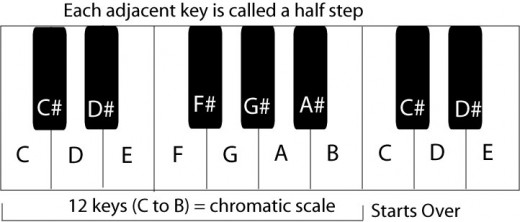
Chromatic Half-Step Scale on Piano Using Sharps (#)
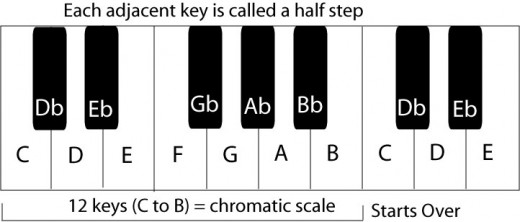
Regarding Sharps & Flats
Simple rule! Memorize this please. Sharps and Flats are always in relation to the white keys and can even be a white key.
The rule is Sharp is one key to the right of a white key. Usually a black key but not always. Flat is one key to the left of a white key, again usually a black key but not always.
The most common error many students make is that they don't include the black keys. For example when they are told to go one key to the right from C they go to to D, which is wrong. It should have been C#/Db. Don 't make this mistake. Take this rule literally and include all the keys.
The intervals (the distance between each note) in a major scale are:
whole step / whole step / half step / whole step / whole step / whole step / half step
abbreviated w w h w w w h
The first major scale most musicians learn is the C major scale:
C D E F G A B C
Major Scale Formula Applied To C Major

The 15 Major Scales
Cb
| Db
| Eb
| Fb
| Gb
| Ab
| Bb
| Cb
|
Gb
| Ab
| Bb
| Cb
| Db
| Eb
| F
| Gb
|
Db
| Eb
| F
| Gb
| Ab
| Bb
| C
| Db
|
Ab
| Bb
| C
| Db
| Eb
| F
| G
| Ab
|
Eb
| F
| G
| Ab
| Bb
| C
| D
| Eb
|
Bb
| C
| D
| Eb
| F
| G
| A
| Bb
|
F
| G
| A
| Bb
| C
| D
| E
| F
|
C
| D
| E
| F
| G
| A
| B
| C
|
G
| A
| B
| C
| D
| E
| F#
| G
|
D
| E
| F#
| G
| A
| B
| C#
| D
|
A
| B
| C#
| D
| E
| F#
| G#
| A
|
E
| F#
| G#
| A
| B
| C#
| D#
| E
|
B
| C#
| D#
| E
| F#
| G#
| A#
| B
|
F#
| G#
| A#
| B
| C#
| D#
| E#
| F#
|
C#
| D#
| E#
| F#
| G#
| A#
| B#
| C#
|
Remember the formula: w w h w w w h
Chords in a Key
The order of chords in a key are:
major - minor - minor - major - major - minor - diminished
For the key of C, the corresponding chords are as follows:
C major - D minor - E minor - F major - G major - A minor - B diminished
The shorthand way of writing chords:
C - Dmi - Emi - F - G - Ami - B dim
Each chord can be represented by a Roman Numeral:
C (I) - Dmi (ii) - Emi (iii) - F (IV) - G (V) - Ami (vii) - Bdim (vii)
Notice the large case numerals for major chords and the small case numerals for the minors and diminished.
Major Scale Formula With Chords

Never Mind The Theory Where's The List?
Here is the list of the chords in all keys. There will be a YouTube link for chords in the key of A using bar chords on the guitar.
Basic Chords In All Keys
I
| ii
| iii
| IV
| V
| vi
| vii
|
|---|---|---|---|---|---|---|
Cb
| Dbmi
| Ebmi
| Fb
| Gb
| Abmi
| Bbdim
|
Gb
| Abmi
| Bbmi
| Cb
| Db
| Ebmi
| Fdim
|
Db
| Ebmi
| Fmi
| Gb
| Ab
| Bbmi
| Cdim
|
Ab
| Bbmi
| Cmi
| Db
| Eb
| Fmi
| Gdim
|
Eb
| Fmi
| Gmi
| Ab
| Bb
| Cmi
| Ddim
|
Bb
| Cmi
| Dmi
| Eb
| F
| Gmi
| Adim
|
F
| Gmi
| Ami
| Bb
| C
| Dmi
| Edim
|
C
| Dmi
| Emi
| F
| G
| Ami
| Bdim
|
G
| Ami
| Bmi
| C
| D
| Emi
| F#dim
|
D
| Emi
| F#mi
| G
| A
| Bmi
| C#dim
|
A
| Bmi
| C#mi
| D
| E
| F#mi
| G#dim
|
E
| F#mi
| G#mi
| A
| B
| C#mi
| D#dim
|
B
| C#mi
| D#mi
| E
| F#
| G#mi
| A#dim
|
F#
| G#mi
| A#mi
| B
| C#
| D#mi
| E#dim
|
C#
| D#mi
| E#mi
| F#
| G#
| A#mi
| B#dim
|
Chord Shorthand: C major = C, C minor = Cmi, C diminished = Cdim
Bar Chords in the Key of A
- Guitar Chords in the Key of A-YouTube
How do you find the next chord when you are writing a song? This video shows how to play chords in the key of A on the guitar using E and A form bar chords. ...
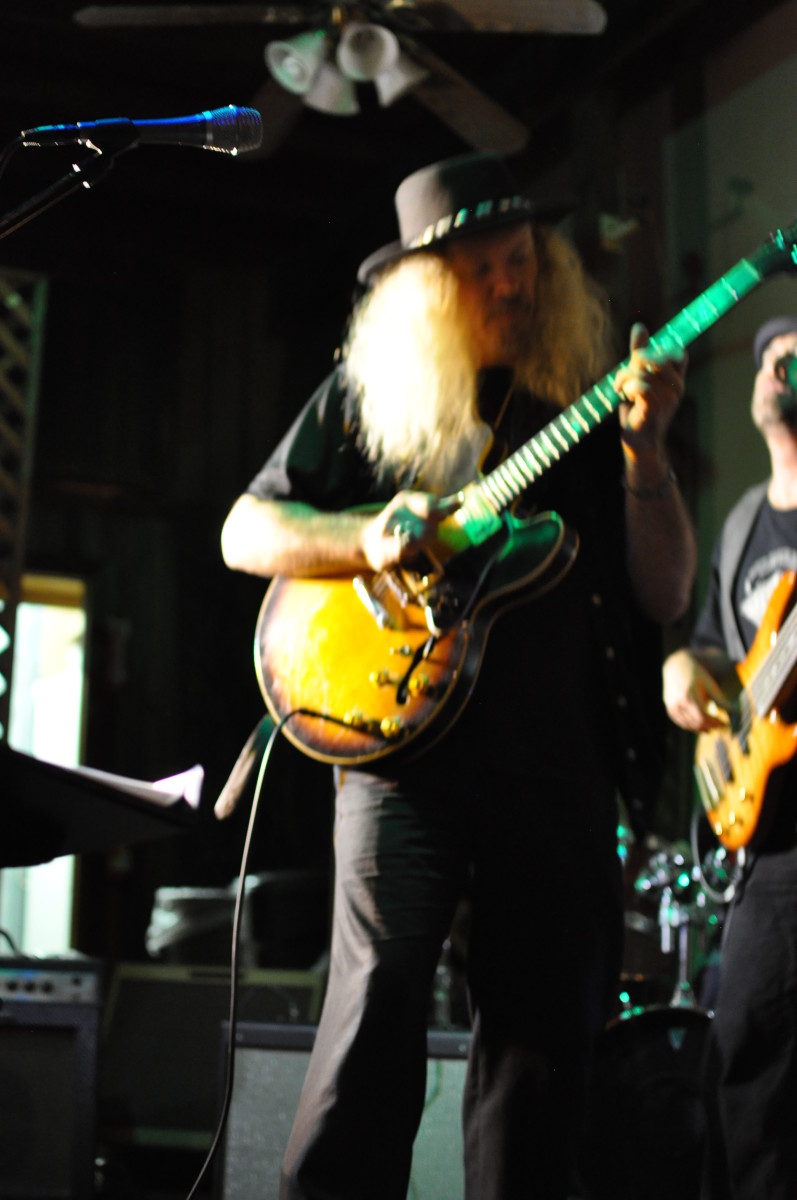
7th Chords in a Key
I
| ii
| iii
| IV
| V
| vi
| vii
|
|---|---|---|---|---|---|---|
Cbmaj7
| Dbmi7
| Ebmi7
| Fbmaj7
| Gb7
| Abmi7
| Bbmi7b5
|
Gbmaj7
| Abmi7
| Bbmi7
| Cbmaj7
| Db7
| Ebmi7
| Fmi7b5
|
Dbmaj7
| Ebmi7
| Fmi7
| Gbmaj7
| Ab7
| Bbmi7
| Cmi7b5
|
Abmaj7
| Bbmi7
| Cmi7
| Dbmaj7
| Eb7
| Fmi7
| Gmi7b5
|
Ebmaj7
| Fmi7
| Gmi7
| Abmaj7
| Bb7
| Cmi7
| Dmi7b5
|
Bbmaj7
| Cmi7
| Dmi7
| Ebmaj7
| F7
| Gmi7
| Ami7b5
|
Fmaj7
| Gmi7
| Ami7
| Bbmaj7
| C7
| Dmi7
| Emi7b5
|
Cmaj7
| Dmi7
| Emi7
| Fmaj7
| G7
| Ami7
| Bmi7b5
|
Gmaj7
| Ami7
| Bmi7
| Cmaj7
| D7
| Emi7
| F#mi7b5
|
Dmaj7
| Emi7
| F#mi7
| Gmaj7
| A7
| Bmi7
| C#mi7b5
|
Amaj7
| Bmi7
| C#mi7
| Dmaj7
| E7
| F#mi7
| G#mi7b5
|
Emaj7
| F#mi7
| G#mi7
| Amaj7
| B7
| C#mi7
| D#mi7b5
|
Bmaj7
| C#mi7
| D#mi7
| Emaj7
| F#7
| G#mi7
| A#mi7b5
|
F#maj7
| G#mi7
| A#mi7
| Bmaj7
| C#7
| D#mi7
| E#mi7b5
|
C#maj7
| D#mi7
| E#mi7
| F#maj7
| G#7
| A#mi7
| B#mi7b5
|
Chord Theory
So you want to know how things work because you are bored with just knowing the chords right?
A chord is made by combining every other note of a scale. But only uses 3 notes to make basic major, minor, diminished and augmented chords. (No augmented for now)
Take a C major scale CDEFGAB. Every other note (using only 3 notes) from C would be CEG which is the 1st, 3rd and 5th note. 1st, 3rd, 5th, is sometimes also called root, 3rd, 5th and is standard music terminology. This makes a C major chord.
If you combine every other note from D in the C scale you get DFA which is the D minor chord. And even though that is technically the 2nd, 4th and 6th of the C major scale, it would still be thought of as the 1st, 3rd and 5th in relation to D.
Three note chords are called triads. In guitar chords there are typically 4, 5 or 6 string involved, however if the chord is just a minor or major this means it has only 3 different notes with duplicates of one or more of the 1st/root, 3rd and 5th.
The Difference Between Major and Minor coming up in the next section.
The Difference Between Major and Minor Chords
Back to the intervals.
For major chords the distance between the 1st and 3rd; C and E using the C major scale as a reference, is 4 half-steps. The distance between the 3rd and 5th; G and E is 3 half-steps
For minor chords the distance between the 1st and 3rd; D and F using D minor as an example is 3 half-steps. The distance between the 3rd and 5th; F and A is 4 half-steps.
Guitarists Learn Your Bar Chords
Augmented and Diminished
For diminished chords the distance between the 1st and 3rd; B and D using the C major scale as an example is 3 half-steps. The distance between the 3rd and 5th; D and F is 3 half-steps. This would be a B diminished chord.
For augmented chords which are not in major scales, the distance between the 1st and 3rd; C and E using C augmented as an example is 4 half-steps. The distance between the 3rd and 5th; E and G# is 4 half-steps.This would be C augmented also known as the +5 or #5 chord.

7th, 9th, 11th and 13th Chords
7th chords are every other note using 4 notes
9th chords are every other note using 5 notes
11th chords are every other note using 6 notes
13th chords are every other note using 7 notes
More On What Goes In Chord Construction
© 2018 Mark Edward Fitchett


